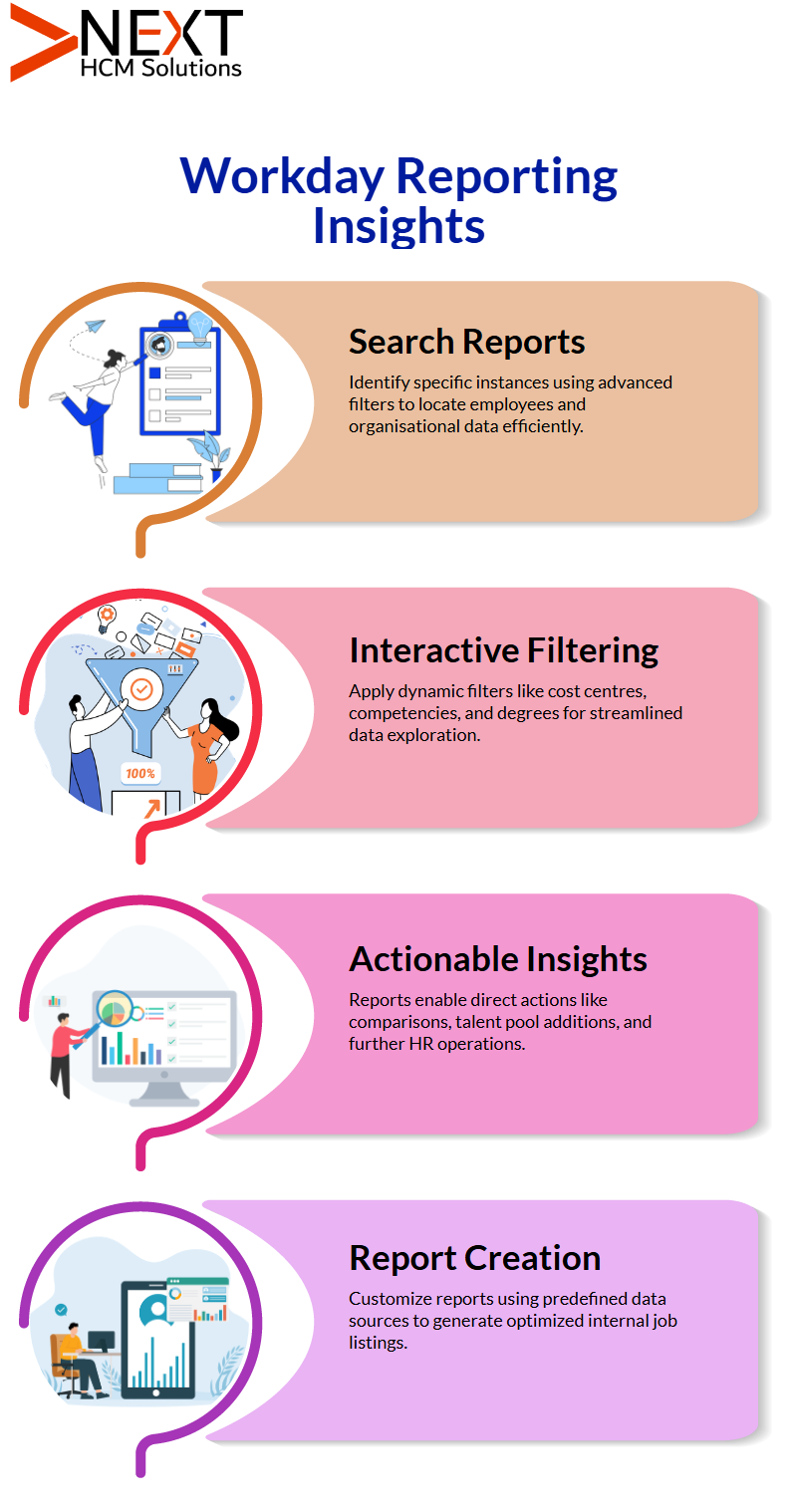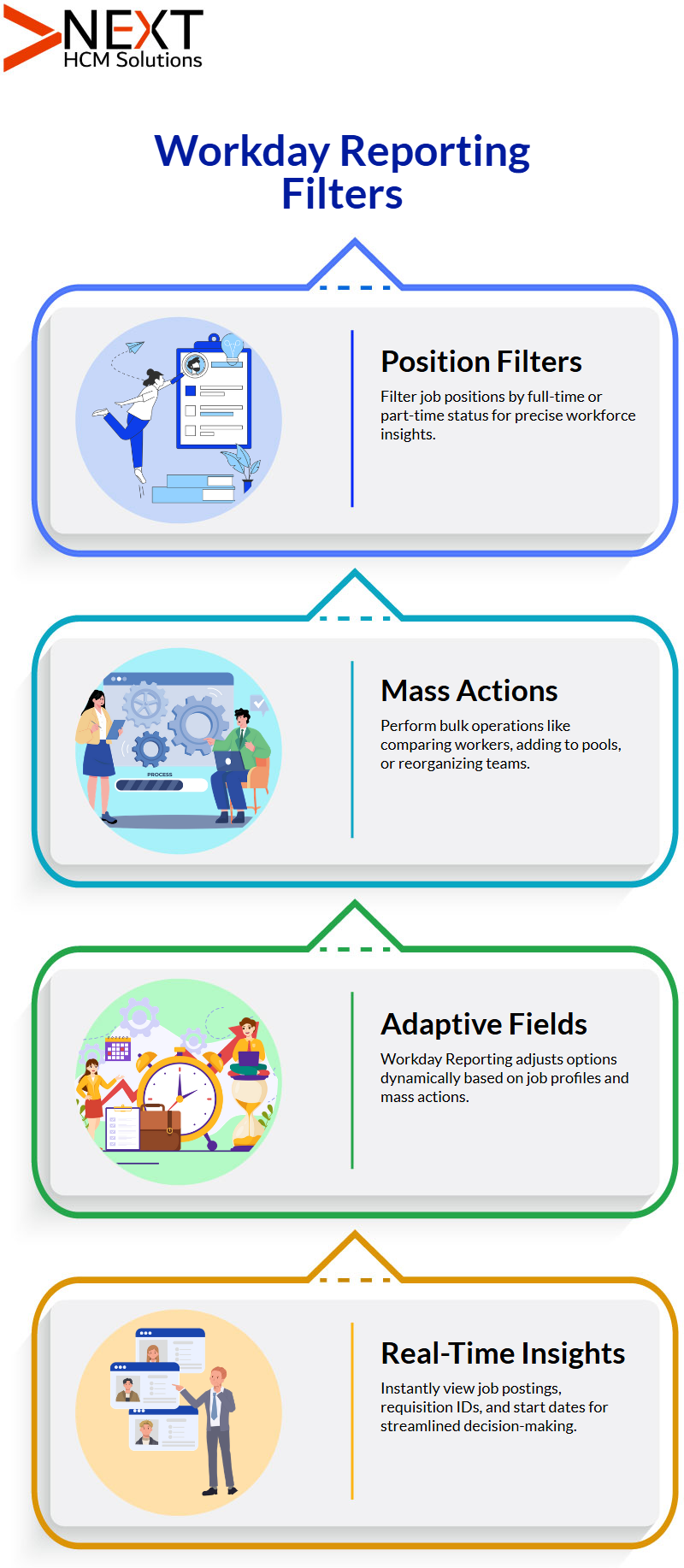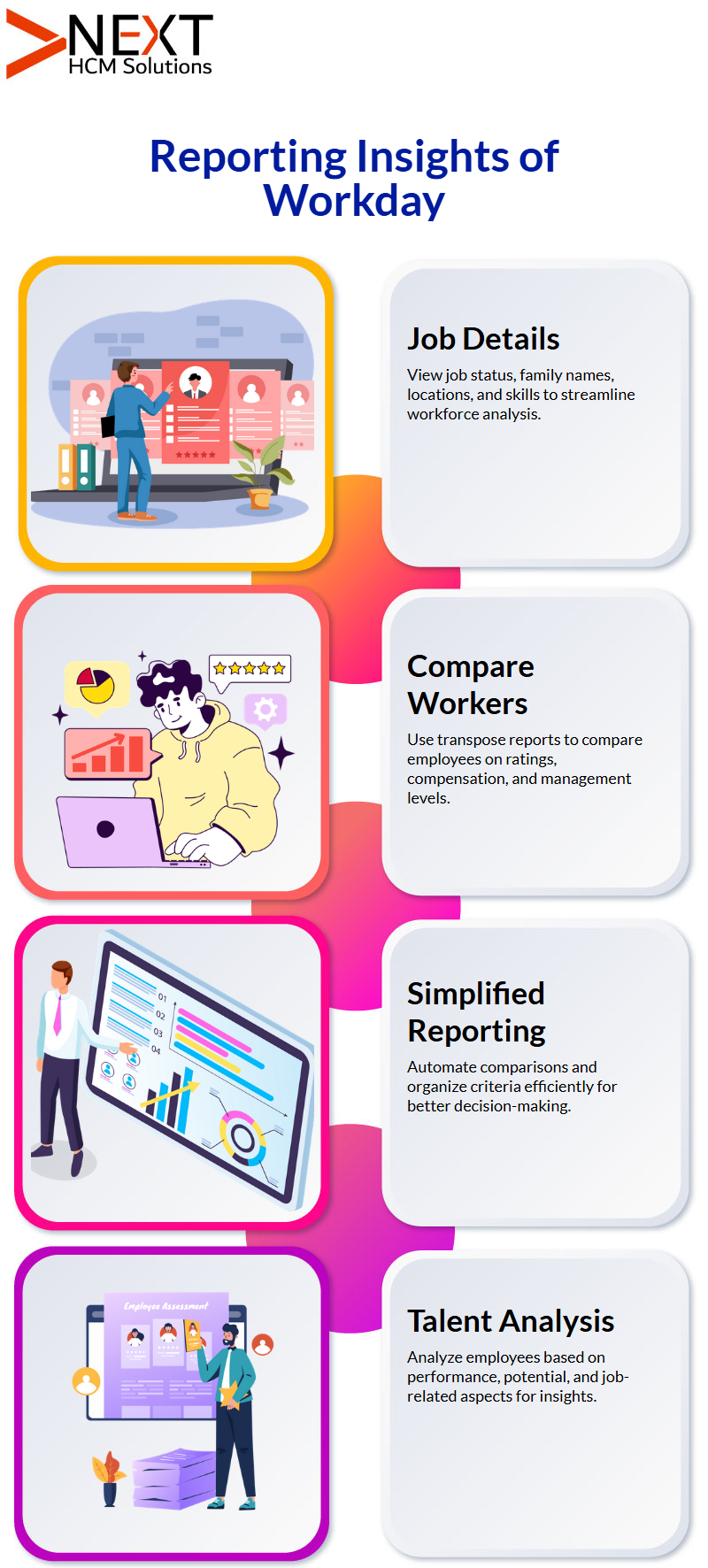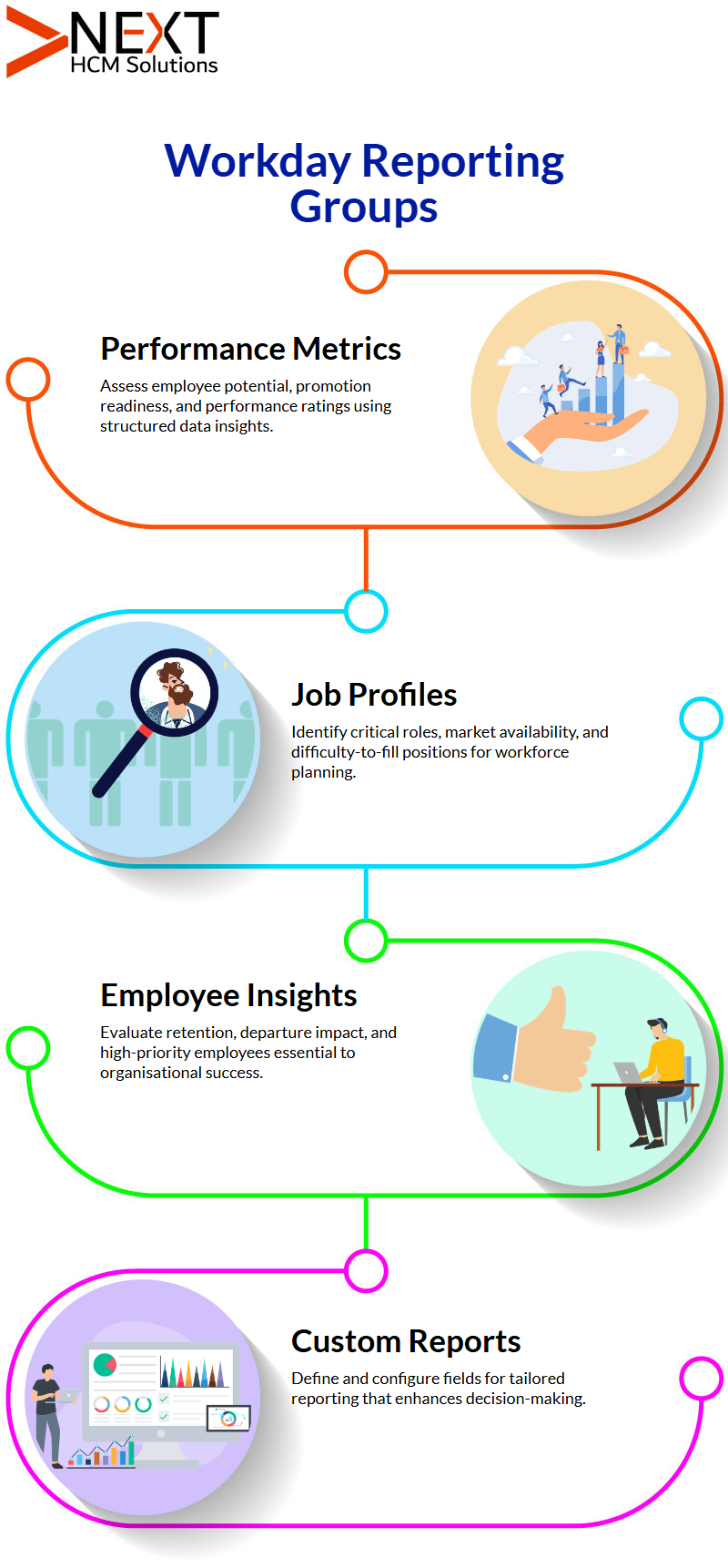Join the Best Workday Training in Bengaluru to Learn, Practice and Suceed
Workday Reporting Training in Bengaluru
Training Blueprint
Let’s dive right into Workday Reporting by exploring search reports these are among the easiest and most interactive reports you can create, needing minimal logic.
Search reports in Workday Reporting allow you to identify specific instances or objects within Workday and filter data based on specific criteria.
An example of such a search report would be the “Find Worker” report, which is explicitly designed to locate employees using advanced filters.
Your report output allows immediate action to be taken directly from its production. Running this report displays all employees in your organisation with details including name, employee ID number, location, and job profile—providing an efficient way to explore data related to workers in an organised way.
These features of Search Reports in Workday Reporting are also emphasised in Workday Reporting Training in Bengaluru, where participants gain hands-on experience using real-time interactive filtering.
This includes filtering workers by company directly without adding hard-coded prompts into a report, using criteria such as cost centres, competencies, degrees, or fields of study as filters.
Beyond filtering, Workday Reporting allows users to take other actions with selected workers, such as comparing, adding to talent pools, or performing other tasks directly from the report interface.
Search reports in Workday Reporting offer powerful ways of quickly exploring specific data instances while efficiently performing tasks, skills thoroughly covered in Workday Reporting Training in Bengaluru.
Creating Search Reports in Workday Reporting
Let me walk you through creating a search report in Workday Reporting using the Find Open Jobs report as an example.
This report displays all open internal job postings within an organisation to allow employees to explore opportunities for internal movement and career advancement.
To create this report, select a search report optimised for performance as the report type. Herein lies its data source in the form of Job Posting Anchor, which lists all job listings within its tenant, including internal, external and agency-related postings.
As part of your report creation, focus on internal job postings and exclude confidential or external postings before filtering and summarizing accordingly.
Select which fields should appear in the Search Results Tab, such as the job posting name as the primary field. Workday Reporting ensures these fields are displayed clearly for easy navigation.
This example is commonly used in the Workday Reporting Training in Bengaluru, where participants learn to create and customise reports efficiently.

Customising Search Reports in Workday Reporting
Workday Reporting allows for extensive customisation of search reports. Users can add filters and select specific fields as part of the report output.
With such flexibility at your disposal, reports can be customised specifically to your organisation’s unique requirements.
For instance, the “Find Open Jobs” report lets you showcase job postings relevant to internal employees.
By customising filters and fields, you ensure that data presented to users exploring internal opportunities remains meaningful and actionable.
Workday Reporting Configuration Made Simple
Setting the primary field for Workday Reporting is crucial; always choose the highlighted blue field as my result field of choice.
Set job acquisition ID as the main result field and feature three related fields below worker details for job acquisition IDs.
For job postings, feature essential info like start date and location. These fields allow me to pinpoint the starting date for hiring and its exact location (whether India, USA or elsewhere) when employing Workday Reporting’s search results and sort tab.
Workday Reporting makes internal job postings even more potent by restricting them to positions available within an organisation, thus eliminating external applicants from applying.
Facet filters are another exciting Workday Reporting feature extending real-time reporting capabilities.
Facet filters work when your data source is indexed and your report type is either matrix, trended, or search-based.
When creating a search report, add fields such as countries, location hierarchies, job families and profiles. Filtering by job family lets me view marketing job profiles under one category.
The Workday Reporting Training in Bengaluru thoroughly explores these features and configurations, making it an essential learning opportunity for anyone looking to master custom report creation in Workday.
Workday Reporting's Filters Are Powerful Tools
Filtering options within Workday Reporting make the reporting system shine, such as job families, which categorise job profiles into structured groups for reporting purposes.
Marketing as a job family encompasses multiple profiles. Filtering related to job profile links the job family to positions.
Reports include filters explicitly tailored to hiring managers; for instance, Workday Reporting helps quickly identify internal positions managed by specific individuals.
Workday makes these tasks intuitive for users, whether filtering roles by country, position within specific hierarchies or skill sets.
Advanced filters offer unparalleled flexibility. By grouping job profiles and linking them through job families, Workday Reporting ensures filters remain comprehensive yet straightforward.
These practical applications are thoroughly demonstrated during the Workday Reporting Training in Bengaluru, where participants gain hands-on experience with advanced filtering and report customisation.

Filtering Job Positions in Workday Reporting
Unpacking how Workday Reporting’s filtering feature can come in handy to narrow down positions by full or part-time status, for instance.
Workday Reporting’s action instance selection field allows you to take specific actions if working with workers there’s plenty to discover here! But for job positions, some options might appear blank—don’t worry Workday Reporting adapts according to its data and automatically populates these fields with options based on mass actions and job profiles in Workday Reporting.
Mass actions in Workday Reporting! These enable you to take actions on multiple records at the same time.
For example, you can select and compare workers before adding them to a pool or taking other actions, like moving them to a supervisory organisation.
Job profiles don’t offer as much versatility, but that is part of Workday Reporting’s beauty: its capabilities adapt according to what type of data is being handled by its user.
These dynamic features are explored in depth during the Workday Reporting Training in Bengaluru, where users get hands-on experience with mass actions, filters, and data-driven adaptability in Workday.
Have You Experienced Workday Reporting Benefits ?
Working reports in real time through Workday Reporting is easy. View job posting names, requisition IDs, position start dates and countries quickly in an intuitive interface; plus, it lets you filter data in real-time! Plus, it even enables you to filter results instantly!

Checking Workday Reporting
Check whether jobs are full-time or part-time; view job family names and details like manager names, location/country information and required skills – it’s almost like having your personalised dashboard!
With Workday Reporting, you can even compare workers!! Comparing Workers in Workday Reporting:
Workday Reporting offers users a powerful feature: compare workers using transpose reports. Suppose you have 10 team members to compare using transpose reports at their performance ratings, potential ratings, compensation levels, management levels or anything else relevant.
You select some employees and compare them on multiple criteria in real-time no need for separate reports to run numerous times!
Let’s examine the transpose reports in Workday Reporting more closely these reports allow users to compare objects against specific criteria easily and conveniently.
Workday Reporting’s user-friendly layout effortlessly organises everything for its clients – compensation data such as base pay and range grades, qualifications and certifications or talent information like performance ratings or potential data.
Your spreadsheet allows you to group criteria into larger groups before subdividing further for greater insight.
Simplify Reporting Tasks in Workday Reporting
With Workday Reporting at your disposal, reporting tasks become simple and effective. Whether that means comparing employees in an applicant pool or collecting detailed job posting information, Workday makes the entire process efficient and seamless.
Automating comparisons and categorising criteria will save time juggling data while giving more of your energy toward making informed decisions.
You could look to Workday Reporting for Comparing Talent by Organisation as one method.
Let’s dive deep into Workday Reporting and understand how to compare employees based on organisational talent data.
While creating reports, focus on essential details regarding performance, potential and job-related aspects.
Such reports are powerful tools allowing organisations to make more effective data-driven decisions.
As the starting point, create a report and name something significant like “Compare Talent by Organisation.” Prefer using an established data source, which makes this task simpler.
Select the ‘Worker by Organisation’ data source since it provides a prompt that aligns with my Workday Reporting needs.

Setting Up Groups in Workday Reporting
The organisation of data in Workday Reporting makes reports more insightful. During the Workday Reporting Training in Bengaluru, the first group in Workday Reporting was created, called the Performance Group; within it are fields for top performer status (Boolean), current performance ratings, and talent matrix placement.
These fields help visualise whether an employee exceeds expectations, meets goals, or falls short. Workday Reporting allows me to assess whether an employee demonstrates high potential.
Metrics like achievable levels that estimate promotion readiness within one to four years provide helpful insight. Such details add depth to any report.
Implement Job Profile Details in Workday Reporting
Employing work profile-relevant details in Workday Reporting can be essential. Create a separate group dedicated solely to this data, keeping its initial collapsed state for an easier view.
Fields such as ‘difficult to fill” and “critical job status” become crucial factors. If an employee vacates a vital position, consider how challenging it will be to fill their shoes; understanding the market availability of niche skills also plays an important part here.
Assess whether the role is essential to the organisation’s success and identify any gaps efficiently using Workday Reporting, giving me concrete data upon which to base strategic recommendations.
Workday Reporting to Gain Employee Insights
Workday Reporting can play a critical role in managing an organisation. Imagine needing to understand each employee’s contribution something you can master during the Workday Reporting Training in Bengaluru to make your app run more effectively!
Workday Reporting makes it possible to evaluate retention and assess any ramifications from employees leaving, providing invaluable data-driven reports about high-priority employees essential to your organisation’s success.
It is flexible, enabling users to define and customise fields according to their tastes and requirements.
It offers many settings designed for straightforward navigation; for instance, it can do that if you want all fields to appear left-justified. However, it is best used when maintaining simplicity in settings.

Enabling Filters and Prompts to be Dynamic in Workday Reporting
With Workday Reporting’s flexibility to add filters and prompts, making the report dynamic and user-friendly, it is even simpler with its labels ‘Workers by Organisations’, which automatically includes organisation prompts for seamless data access. You can share these reports among various user groups for enhanced collaboration.
Running reports for smaller organisations is made simple within Workday Reporting, creating clarity.
While large datasets can sometimes become daunting, selecting specific regions – say, France instead of America – allows for concise insights.
Workday Reporting streamlines this process while simultaneously providing targeted data.
Workday Reporting Allows for Effective Employee Evaluation
One of Workday Reporting’s significant advantages is that it reveals areas requiring improvement – for instance, you can assess whether employees meet expectations while pinpointing areas needing focus.
These reports offer comparative insight into employee performance, helping you make more informed decisions.
Recently used Workday Reporting without including specific fields for employee-related details that would have enhanced its output, which may have provided greater results.
The tool’s functionality provided a clear view of our workforce’s strengths and weaknesses, making for greater insights.
Features in Workday Reporting
Workday Reporting offers solutions tailored specifically for organisations heavily relying on talent and performance modules, providing targeted workforce evaluations when appropriately utilised.
Typically used for rare reports requiring complex workforce analyses, you can gain valuable skills in maximising these features during the Workday Reporting Training in Bengaluru.
Workday Reporting’s collapsible views provide another beneficial feature: reports may appear collapsed by default; you’ll gain detailed insights by expanding them further.
You might find them handy for drilling down to specific data points without overwhelming the overall report structure.

